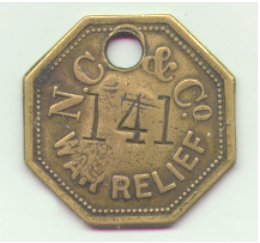
A Coal Company "War Relief" Check - What is it?

A brass embossed check bearing the legend N.C. & Co. WAR RELIEF. Obverse stamped with the number "141" while reverse has been stamped with the legend "EE5". Actual size 30 mm.
I came across the above check via an ex-miner from Yorkshire several years ago. He had in his possession this check plus one other which was round (33 mm dia.) and brass embossed. The second check was stamped with a different identification number to the one above and bore the legend "N.C. & Co. PARKGATE COLLIERY". The owner of these checks thought that they had both been in his family some time but had no further information about them. It is possible that both checks emanated from the same pit, in this case Parkgate Colliery. They were certainly both issued by the same Colliery Company - Newton Chambers & Company Limited.
Newton Chambers owned several collieries located between Sheffield and Barnsley up until 1947. They also operated at least one iron works in Rotherham. Their collieries included Rockingham, Grange, Tankersley, Smithywood and Thorncliffe. Ironstone was also worked at the latter mine.
The chance encounter of these two checks raised several immediate questions to me;
1) Where was Parkgate Colliery?
2) What was a "war relief" check and how had such checks been used?
3) From when did the two checks date? Was the "war" referred to in "war relief" the First or Second World War?
As yet I have not found any answers to the above queries. I can find no reference in any contemporary colliery directories to Newton Chambers having a "Parkgate Colliery". Many of their pits worked the famous Parkgate seam and Thorncliffe Colliery included a Parkgate Drift (for which at least one named brass embossed N.C. & Co. check is known). However, I can find no record of a separate Parkgate Colliery.
As to the to the "War Relief" check this appears to be an even bigger mystery to every one I have discussed it with. I can find no other collector of colliery or industrial checks that has ever come across anything remotely similar to it. While several collectors have suggested a date of 1914-18 for the issue of this check this remains solely supposition. At least one collector has speculated that such checks could have been issued to differentiate conventional colliers from conscripted "Bevin Boy" miners during the Second World War. However, I have yet to hear confirmation of such a practice being used at any British pit by ex-Bevin Boys.
If anyone can help me further with the above queries I would be most grateful.